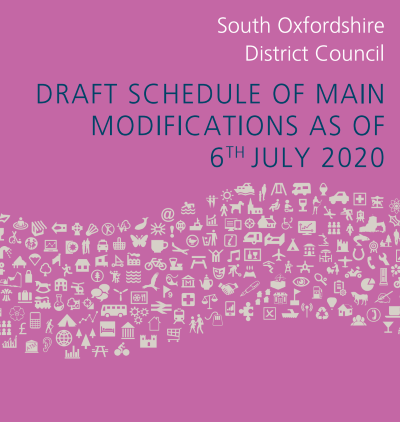First clues to Local Plan 2034 changes
On 30/08/2020 At 4:26 pm
Category : Missed a ThameNews story?, More News, Thame news
Responses : No Comments

THE first official comments from the Planning Inspector who over-saw the recent Public Inspection of South Oxfordshire’s Draft Local Plan 2034, have been received in a letter to SODC, and he has much to say that affects Thame.
The Market towns
The Inspector, Mr Jonathan Bore, acknowledges that the market towns have seen very considerable growth and have a large volume of commitments, and that they don’t represent ‘a reasonable alternative to the strategic allocations (the large brown and greenfield sites allocated for development in the plan), partly because they are located some distance away from major centres of housing and employment, and partly because of the need to protect their character and their historic centres and ensure that their community facilities do not come under excessive pressure.
BUT, he then goes on to say: “Nonetheless, they are some of the best connected and most sustainable settlements in the district and have a role in delivering housing to meet the overall requirement and local needs.”
He continues to say that there is no convincing evidence of a need to keep additional housing numbers in Neighbourhood Plans below 15% of the numbers allocated in 2011, to avoid harm to any of the towns, the surrounding landscape, the AONB or other designations. In fact, he states, such a limit could be seen as putting a cap on development.
More new homes for Thame
He concludes this section: “To ensure that the plan takes a positive approach towards sustainable development opportunities in the market towns, the housing requirements for the market towns, and the outstanding requirement for neighbourhood development plans (339 more homes for Thame), should be expressed as minima. The policy should also indicate that NDPs should seek to meet demonstrable local needs, for example for specialist or affordable housing, even where this would result in housing provision in excess of the minimum outstanding requirement.”
Employment Land
Thame has a particular shortage of land designated for employment purposes, following several such sites in recent years being built on or adapted from offices to homes under ‘Permitted Development Rights’. In a presentation at the Inspection hearing, Thame Town Council’s Neighbourhood Plan Continuity Officer, Graeme Markland, told the inspector that the 3.5 hectares of employment land in the Local Plan 2034 is ‘inadequate’ to replace what has been lost (See Link),.
The Inspector’s comments do not go as far as Thame would appear to have hoped, but leave some room for flexibility: “ The submitted plan is not positive enough in its approach to the provision of employment land, particularly given the evidence of demand. Main modifications (to the draft Local Plan) are required to make it clear that the employment land requirements are minima, with the requirement for Thame increased to a minimum of 3.5ha.”
Climate Change Mitigation
Insufficient consideration to Climate Change in the Plan was one of the main reasons why the current administration of South Oxfordshire District Council wished to amend, or even scrap much of the draft plan that was drawn up by its predecessor administration. Although there had been robust presentations to the inspector, from several SODC councillors, the CPRE and others, Mr Bore states: “Other than described below (Carbon and energy impacts and sustainable design), the plan adequately addresses this issue.
“The spatial strategy seeks to locate new development in sustainable locations which provide travel choices and help to reduce journey lengths. Its strategic allocations are of a size to sustain social and community facilities and support public transport.
“Carbon and energy impacts are not clearly addressed in the submitted plan and the Council have put forward a new policy on the subject (new DES11 in document CSD13), partly modelled on that in the Oxford City Local Plan. There are also proposed amendments to DES9 regarding sustainable design which can go forward as main modifications for consultation.“
Good news for building standards for new developments
Policy DES9 in the Local Plan, states: ‘All new development should be designed to improve resilience to the anticipated effects of climate change. Proposals must demonstrate that they are seeking a reduction in greenhouse emissions through location, building orientation, design, landscape and planting’.
Policy DES 11 states: ‘Carbon Reduction 1. Development proposals for; i) new build residential dwelling houses; or ii) developments including 1,000m2 or more of C2 use (including student iii) Houses in Multiple Occupation (C4 use or Sui Generis) floorspace are required to achieve at least a 40% reduction in the carbon emissions from a code 2013 Building Regulations (or future equivalent legislation) compliant base case. This reduction is to be secured through on-site renewable energy and other low carbon technologies (this would broadly be equivalent to 25% of all energy used) and/ or energy efficiency measures. The requirement will increase from 31 March 2026 to at least a 50% reduction in carbon emissions and again from 31 March 2030 to a 100% reduction in carbon emissions (Zero Carbon). 2. Non-residential development proposals are required to meet the BREEAM excellent standard (or a recognised equivalent assessment methodology) in addition to the following reductions in carbon emissions’
Biodiversity
Some modifications in respect of biodiversity net gain have been made by the inspector. He states: “Site allocation masterplans need to actively seek biodiversity gain and avoid habitat fragmentation and this needs to be included as a main modification.”
What happens next?
SODC will finalise the main modifications for consultation and sustainability appraisal, agreeing final wording with the inspector. Then there will be an opportunity for the public and stakeholders to comment on the main modifications during the consultation period. Mr Bore will then consider the responses to that consultation and any associated sustainability appraisal before finalising his report.
You can read the inspector’s letter and the full Draft Schedule of Proposed Modifications document CSD13, from his link to SODC’s webpage

